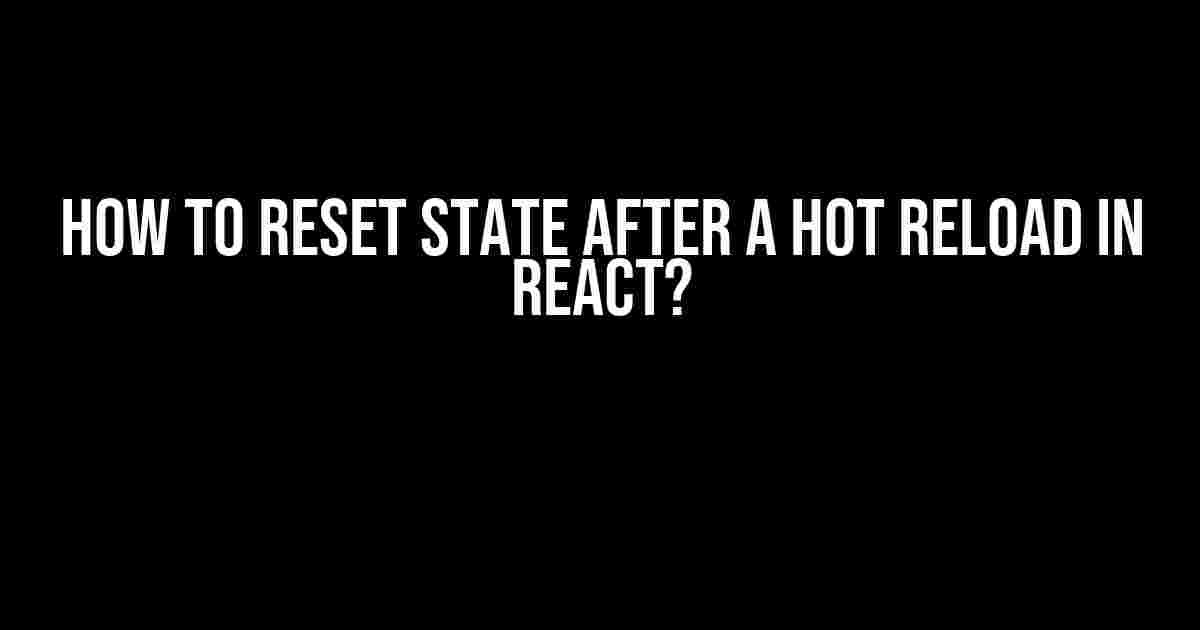Are you tired of seeing your React application’s state getting messed up after a hot reload? Do you find yourself constantly wondering why your state is not resetting as expected? Well, wonder no more! In this article, we’ll explore the world of hot reloading in React and provide you with a comprehensive guide on how to reset state after a hot reload.
What is Hot Reloading?
Before we dive into the meat of the article, let’s quickly cover what hot reloading is. Hot reloading is a feature in React that allows you to see the changes you make to your code without having to reload the entire page. It’s like having a superpower that lets you edit your code and see the results in real-time!
Hot reloading is made possible by a combination of technologies, including Webpack, Babel, and React’s own development tools. When you make changes to your code, Webpack recompiles the changed files and injects the updated code into the browser. React then takes care of re-rendering the components with the new code.
The Problem with Hot Reloading and State
So, what’s the problem with hot reloading and state? Well, when you make changes to your code and save the file, the entire application is re-rendered with the new code. This can cause issues with your application’s state, especially if you’re using React’s Hooks or Redux.
Think of it like this: when you make changes to your code, the state of your application is not automatically reset. This means that the state from the previous code is still present, and it can cause conflicts with the new code. This can lead to unexpected behavior, errors, and even crashes.
Why Do We Need to Reset State After a Hot Reload?
So, why do we need to reset state after a hot reload? There are several reasons:
-
Consistency**: By resetting the state after a hot reload, you ensure that your application is in a consistent state, which makes it easier to debug and test.
-
Accuracy**: Resetting the state helps to prevent errors and unexpected behavior caused by lingering state from the previous code.
-
Development Speed**: By resetting the state, you can quickly test and iterate on your code changes without having to worry about the state from the previous code.
How to Reset State After a Hot Reload?
Now that we’ve covered the importance of resetting state after a hot reload, let’s dive into the ways to do it.
Method 1: Using the `useCallback` Hook
One way to reset state after a hot reload is to use the `useCallback` hook. This hook allows you to memoize a function and its dependencies, so that when the dependencies change, the function is re-created.
import { useCallback, useState } from 'react';
function MyComponent() {
const [count, setCount] = useState(0);
const handleIncrement = useCallback(() => {
setCount(count + 1);
}, [count]);
return (
<div>
<p>Count: {count}</p>
<button onClick={handleIncrement}>Increment</button>
</div>
);
}
In this example, the `handleIncrement` function is memoized using `useCallback`. When the `count` state changes, the `handleIncrement` function is re-created, which resets the state.
Method 2: Using the `useEffect` Hook with an Empty Dependency Array
Another way to reset state after a hot reload is to use the `useEffect` hook with an empty dependency array. This will cause the effect to run only once, when the component mounts, and not again when the state changes.
import { useState, useEffect } from 'react';
function MyComponent() {
const [count, setCount] = useState(0);
useEffect(() => {
setCount(0);
}, []);
return (
<div>
<p>Count: {count}</p>
<button onClick={() => setCount(count + 1)}>Increment</button>
</div>
);
}
In this example, the `useEffect` hook is used to set the `count` state to 0 when the component mounts. The empty dependency array ensures that the effect only runs once, and not again when the state changes.
Method 3: Using the `useRef` Hook
Another way to reset state after a hot reload is to use the `useRef` hook. This hook allows you to create a reference to a value that persists across re-renders.
import { useState, useRef } from 'react';
function MyComponent() {
const countRef = useRef(0);
const [count, setCount] = useState(countRef.current);
return (
<div>
<p>Count: {count}</p>
<button onClick={() => setCount(count + 1)}>Increment</button>
</div>
);
}
In this example, the `useRef` hook is used to create a reference to the `count` state. When the component re-renders, the `count` state is reset to the value of the `countRef`.
Conclusion
In conclusion, resetting state after a hot reload is an essential part of building robust and maintainable React applications. By using one of the methods outlined in this article, you can ensure that your application’s state is consistent and predictable, even after a hot reload.
Remember, hot reloading is a powerful tool that can speed up your development process, but it requires careful management of state to avoid errors and unexpected behavior.
Best Practices for Resetting State After a Hot Reload
Here are some best practices to keep in mind when resetting state after a hot reload:
-
Use a consistent approach**: Choose a method for resetting state and stick to it throughout your application.
-
Keep it simple**: Avoid using complex logic or side effects to reset state. Instead, use simple and predictable methods like the ones outlined in this article.
-
Test thoroughly**: Make sure to test your application thoroughly after implementing a state reset mechanism to ensure that it works as expected.
| Method | |
|---|---|
| useCallback | Memoizes a function and its dependencies, so that when the dependencies change, the function is re-created. |
| useEffect with an empty dependency array | Runs an effect only once, when the component mounts, and not again when the state changes. |
| useRef | Creates a reference to a value that persists across re-renders, allowing you to reset state by updating the reference. |
I hope this article has provided you with a comprehensive guide on how to reset state after a hot reload in React. By following the methods and best practices outlined in this article, you’ll be able to build robust and maintainable React applications that take full advantage of hot reloading.
Frequently Asked Question
Hot reloading in React can be a game-changer for developers, but what happens when you need to reset your state after a hot reload? We’ve got the answers to your most pressing questions!
Q1: What happens to my state after a hot reload in React?
When you reload a React application, the entire application is re-rendered, and the state is lost. This means that any changes you made to the state before the reload will be discarded, and you’ll start with a fresh slate.
Q2: How do I persist my state after a hot reload in React?
One way to persist your state is to use a state management library like Redux or MobX, which can store your state in a separate store that’s not affected by hot reloads. Alternatively, you can use the `localStorage` API to store your state locally in the browser.
Q3: Can I use React’s Context API to reset my state after a hot reload?
Yes, you can use React’s Context API to reset your state after a hot reload. By using a context provider, you can store your state in a context that’s not affected by hot reloads, and then retrieve it when the application restarts.
Q4: How do I reset my state to its initial value after a hot reload?
To reset your state to its initial value, you can use the `useState` hook with an initializer function that returns the initial state. This way, when the application restarts after a hot reload, the state will be reinitialized to its original value.
Q5: Are there any libraries that can help me manage state resets after hot reloads?
Yes, there are several libraries available that can help you manage state resets after hot reloads, such as react-fast-refresh, react-hot-loader, and react-refresh. These libraries provide features like automatic state reset, persistence, and more.


